The NVIDIA GeForce RTX 2060 6GB Founders Edition Review: Not Quite Mainstream
by Nate Oh on January 7, 2019 9:00 AM ESTCompute & Synthetics
Shifting gears, we'll look at the compute and synthetic aspects of the RTX 2060 (6GB). As a cut-down configuration of the TU106 GPU found in the RTX 2070, we should expect a similar progression in results.
Starting off with GEMM tests, the RTX 2070's tensor cores are pulled into action with half-precision matrix multiplication, though using binaries originally compiled for Volta. Because Turing is backwards compatible and in the same compute capability family as Volta (sm_75 compared to Volta's sm_70), the benchmark continues to work out-of-the-box, though without any particular Turing optimizations.
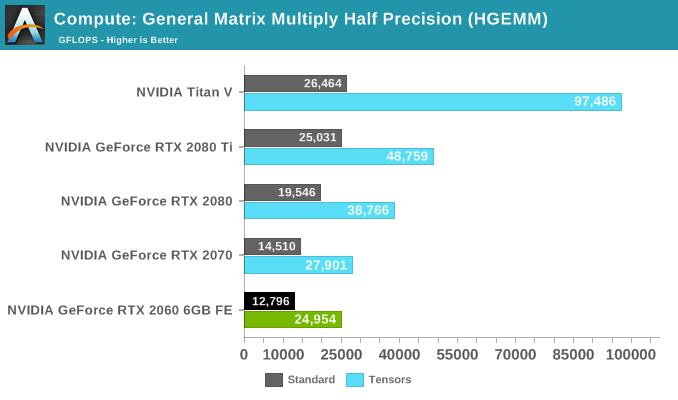
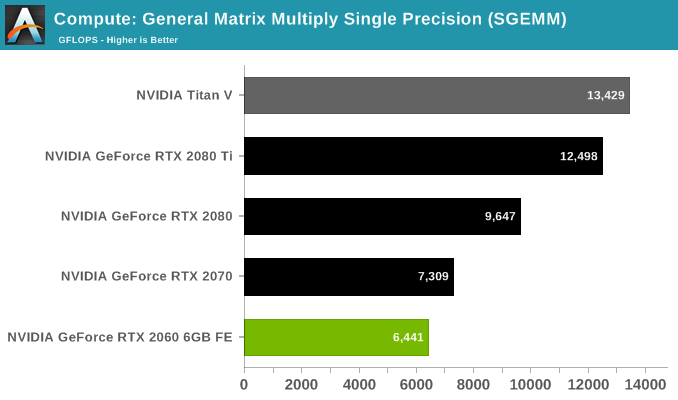
For Turing-based GeForce, FP32 accumulation on tensors is capped at half-speed, thus resulting in the observed halved performance. Aside from product segmentation, that higher-precision mode is primarily for deep learning training purposes, something that GeForce cards wouldn't be doing in games or consumer tasks.
Moving on, we have CompuBench 2.0, the latest iteration of Kishonti's GPU compute benchmark suite offers a wide array of different practical compute workloads, and we’ve decided to focus on level set segmentation, optical flow modeling, and N-Body physics simulations.

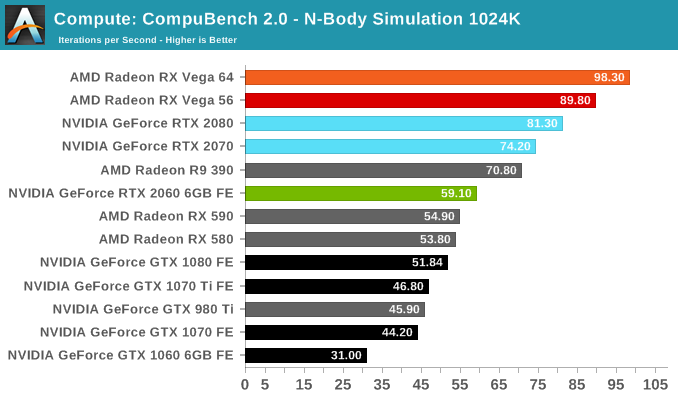
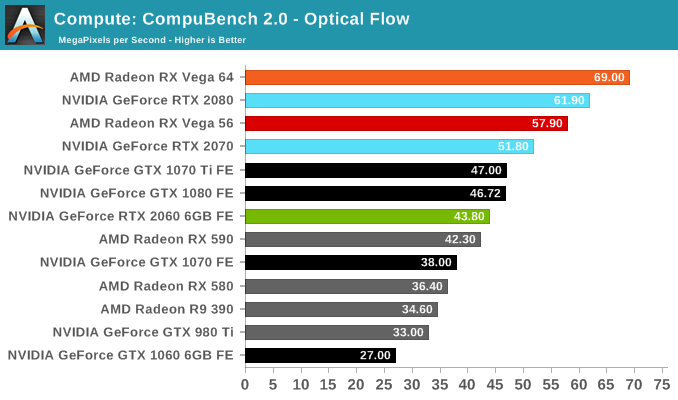
Moving on, we'll also look at single precision floating point performance with FAHBench, the official Folding @ Home benchmark. Folding @ Home is the popular Stanford-backed research and distributed computing initiative that has work distributed to millions of volunteer computers over the internet, each of which is responsible for a tiny slice of a protein folding simulation. FAHBench can test both single precision and double precision floating point performance, with single precision being the most useful metric for most consumer cards due to their low double precision performance.
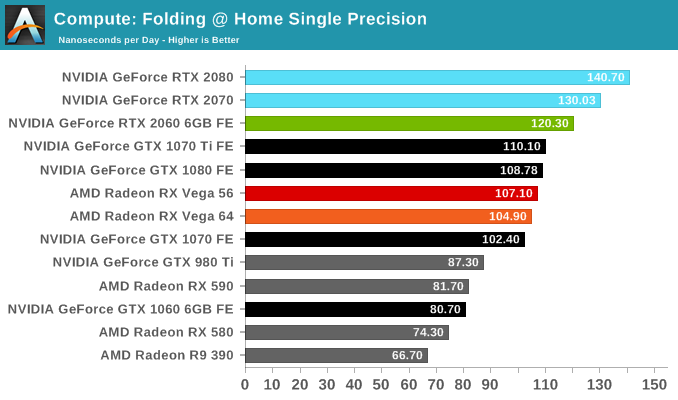
Next is Geekbench 4's GPU compute suite. A multi-faceted test suite, Geekbench 4 runs seven different GPU sub-tests, ranging from face detection to FFTs, and then averages out their scores via their geometric mean. As a result Geekbench 4 isn't testing any one workload, but rather is an average of many different basic workloads.
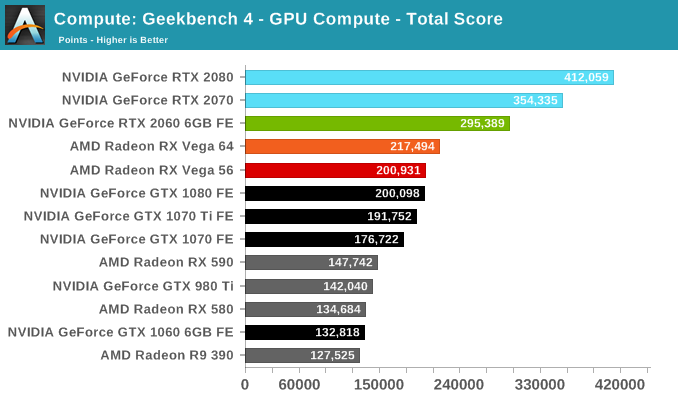
We'll also take a quick look at tessellation performance.
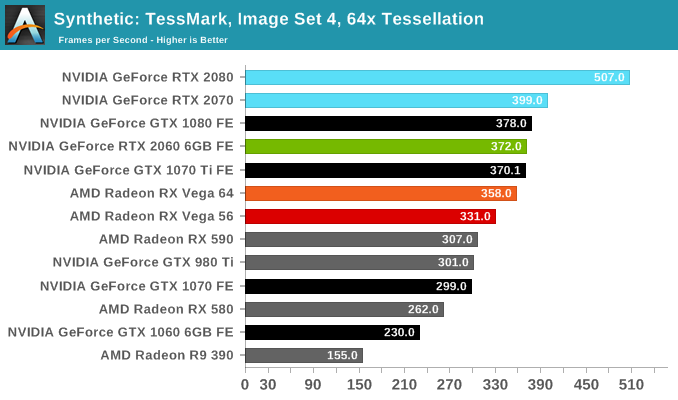
Finally, for looking at texel and pixel fillrate, we have the Beyond3D Test Suite. This test offers a slew of additional tests – many of which use behind the scenes or in our earlier architectural analysis – but for now we’ll stick to simple pixel and texel fillrates.

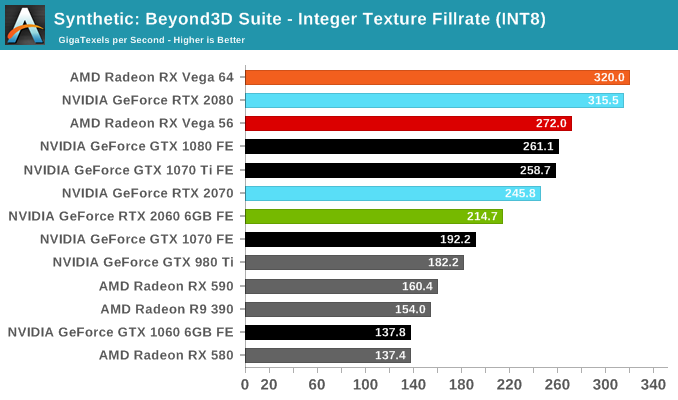










134 Comments
View All Comments
Hameedo - Monday, January 7, 2019 - link
Final Fantasy 15 already supports DLSS via a recently released patch, please correct that infobenedict - Monday, January 7, 2019 - link
Right now the Radeon RX 580 (8GB) has the best price/performance. 590, 1060 and 2060 are much more expensive but not that much faster.Hameedo - Monday, January 7, 2019 - link
The 2060 is on par with 1070Ti, it means it's much faster than 580 and 1060 (about 60%)sing_electric - Monday, January 7, 2019 - link
FWIW, the RX 580 can regularly be had for ~$200 these days, so TECHNICALLY benedict is right - the 580 goes for ~57% of the 2060's MSRP ($349) but offers more like 60-65% of the performance (and that's assuming you can find the 2060 for MSRP, which we'll have to see).IMO, they're just in different markets. The 590 is looking like a misstep by AMD at this point, since it's midway between the 580 and the 2060 in price, but isn't much faster than the 580 in real world performance. The Vega series are interesting, but AMD and partners probably have limited ability to lower prices due to how expensive the HBM2 memory on those boards is.
Bluescreendeath - Monday, January 7, 2019 - link
No, Benedict is not right. At best, he is only partially right on one out of at least three points, and only when viewed in the most favorable light. He said 1) the 2060 is "not much faster," 2) said that the 1060 is much more expensive and 3) said the 580 has the best price/performance ratio. The GTX2060 is clearly significantly faster than the RX580 (by more than 50%) so his first point is flat out wrong. His second point is also wrong because the GTX1060 costs about the same as the RX580 in terms of market price and performs about the same. His 3rd point is debateable and may be right. The 580 does have a marginally better price/performance ratio if you compare market price RX580 ($200) to MSRP GTX2060 ($350). However, if you compare MSRP RX580 ($240+) to MSRP FE GTX2060 ($350) then the equation changes as the RX580 no longer has the best price/performance either as the 2060 is 46% pricier but performs 50-60% better. And other models of the 2060 will surely be cheaper than the FE version.Ananke - Monday, January 7, 2019 - link
He is completely right - RTX2060 has 48 ROPs and 6 GB VRAM, which is pointless at $349, regardless how "fast" is the card. Raytracing is also pointless with so scarcely resourced card.At this point a person should either buy 2080Ti, if money are no object, or buy Radeon 580 8GB for under $200. Most modern games simply manage huge textures in VRAM - you need more RAM, quick memory buses and ROPs for that.
I am no particular fan, but AMD will kill NVidia any moment with announcement of 7 nm chips - at smaller process brute force will have advantage no matter how smart is NVidia's prefetch, bus compression and all other "smart" staff. Same happened to Intel. And TSMC is already occupied working for AMD, Samsung is busy and any excess is reserved by Intel, so NVidia will have no access to 7nm fab for a while
Bluescreendeath - Monday, January 7, 2019 - link
Real world results matter more than on paper specs. The actual real world benchmarks show the Gtx2060 is 50-60% faster than the rx580. You seem to be overly hung up on VRAM and ROPs. Anadtech and techspot have done plenty of tests on VRAM, and modern games dont use nearly as much VRAM as you think - even on 1440p. And take a look at the 4k benchmarks in the article. The 6Gb vram is clearly sufficient. Furthermore, the rx580 8gb costs about $200-250 new, whereas the 2060 is $350 for the more expensive founders edition. Realistically, the aftermarket cards will be something like 200-250 for new rx580s vs 300 for a new non FE 2060.As for your mention of future AMD chips, we are comparing 2060 vs 1060 vs rx580.
heavyarms1912 - Monday, January 7, 2019 - link
Reality check, RX580s 8gb can be had below $200 and even the top end aftermaket ones and with 3 game titles.wintermute000 - Monday, January 7, 2019 - link
And its what 50% slower, so what's your point?Ananke - Tuesday, January 8, 2019 - link
There are several RX580 8GB cards sales today for around $160-170. It night be old, it might be hot, but runs 1080p just perfect on any game, and it costs half.Next generation consoles are already well into making, and developers are developing games for consoles, not for PCs, which will never change since the scale of business is tenfold if not larger. Next might be game services directly integrated in the TV or whatever device gives a mass market, but would never be a PC.
Anyway, new consoles will have A LOT more VRAM, and 6GB will simply not cut it. And they are coming later this year/early next year, not like waiting ten years for it. I have lived through enough NVidia "cycles" and can tell you this is typical NVidia greed - narrow memory bus and limited memory - exactly like 12 years ago, when AMD had nothing, but came with the rough, hot unoptimized 5850 and collected half of the market.
The card is OK, it is just not worth $350 today, that's my point.